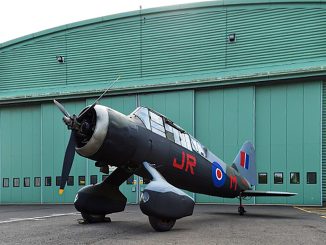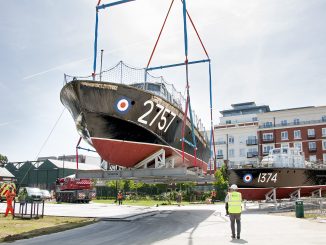
The Royal Air Force Museum’s ultra-rare Vickers Wellington T.Mk.X (MF628) is nearing the conclusion of its decade-long refurbishment at the organization’s Michael Beetham Conservation Center in Cosford, with the fuselage now beginning to receive its first strips of Irish linen covering in the paint booth.
MF628 arrived at RAF Museum Cosford in July, 2010. The primary reason for taking the aircraft off display at the museum’s London campus was that the Wellington’s fabric covering was showing significant signs of deterioration and needed replacing – not an insubstantial task given the airframe’s significant bulk. However, given this opportunity to get into the airframe’s harder-to-reach areas, Museum personnel and volunteers have comprehensively gone through the entire airframe to sympathetically address various conservation issues, including corrosion suppression. This should hopefully see MF628 in a fit state of preservation for the next several decades, and hopefully longer.
Regarding MF628’s future, the Conservation Center’s manager, Darren Priday, mentioned in an interview this summer that he expected to see the Wellington go on display within a Bomber Command exhibit in Hangar 3 at RAF Museum Cosford, rather than returning to London. The museum is also keen to find a way to show off the airframe’s fascinating and unusual geodesic structure (designed by the legendary Barnes Wallis of Dambusters fame) that is normally hidden from view beneath the fabric covering. They are considering whether to leave the tail turret off the aircraft, thus allowing visitors to see far into the fuselage (discretely lit with LED bulbs) through the opening it would provide. It’s an interesting concept, and might make for an effective display, especially if the tail turret is placed beside the exhibit, that way enabling its own features to be highlighted individually.
While the video below is from 2019, Darren Priday takes the viewers around the Michael Beetham Conservation Facility to give an overall impression of the facility and its capabilities. The Wellington features towards the end, but there is a great description of the Handley Page Hampden under restoration under the same roof, along with a useful depiction of the re-fabricing process, then underway on the RAF Museum’s Westland Lysander.
Wellington MF628 is one of just two complete examples, of more than 11,000 produced, in preservation at present. Her initial flight took place on May 9th, 1944, although she never served in combat. As her type designation suggests, MF628 served in the training role during her RAF career, which extended well after WWII had ended. In addition to her normal duties, MF628 also participated in a number of motion pictures, including Malta Story (1952) where she was a picture vehicle, and also The Dambusters (1954) in which her primary role included serving as the camera ship for many of the aerial sequences. Somehow, unlike almost every other WWII RAF bomber, MF628 avoided the scrap man’s axe long enough to make it into preservation. She joined the nascent RAF Museum in 1957. For a more complete description of MF628’s history, please click HERE.
The world’s only other complete Wellington within a museum is Mk.IA N2980, a combat-veteran airframe lifted from its crash site in Loch Ness near Inverness, Scotland during the 1980s, and restored for display at the Brooklands Museum in Weybridge, Surrey. That being said, there are substantial remains from a half dozen other airframes which might one day reconstitute into fully-restored exhibits. Regardless, it will be marvelous to have MF628 back on display again in the not too distant future!
Related Articles

Adoptions Help Keep The RAF Museum Flying
RAF Museum Conservation Center Open House – Nov.11th – 16th
RAF Museum’s Westland Lysander Returned to Her Former Glory
Handley-Page Hampden Fuselage Whole Again at RAF Museum Cosford
RAF Museum – Westland Lysander Update
Upgraded RAF Museum London to Open June 30th
Richard Mallory Allnutt's aviation passion ignited at the 1974 Farnborough Airshow. Raised in 1970s Britain, he was immersed in WWII aviation lore. Moving to Washington DC, he frequented the Smithsonian’s National Air & Space Museum, meeting aviation legends.
After grad school, Richard worked for Lockheed-Martin but stayed devoted to aviation, volunteering at museums and honing his photography skills. In 2013, he became the founding editor of Warbirds News, now Vintage Aviation News. With around 800 articles written, he focuses on supporting grassroots aviation groups.
Richard values the connections made in the aviation community and is proud to help grow Vintage Aviation News.





Be the first to comment
Graphic Design, Branding and Aviation Art